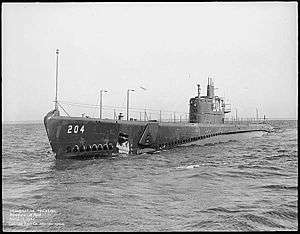USS Mackerel (SS-204)
 | |
| History | |
|---|---|
| Builder: | Electric Boat Company, Groton, Connecticut[1] |
| Laid down: | 6 October 1939[1] |
| Launched: | 28 September 1940[1] |
| Commissioned: | 31 March 1941[1] |
| Decommissioned: | 9 November 1945[1] |
| Struck: | 28 November 1945[1] |
| Fate: | Sold for scrap, 24 April 1947[1] |
| General characteristics | |
| Class and type: | Mackerel-class submarine[2] |
| Displacement: | |
| Length: | 243 ft 1 in (74.09 m)[3] |
| Beam: | 22 ft 1 in (6.73 m)[3] |
| Draft: | 13 ft ¼ in (4.0 m)[3] |
| Propulsion: |
|
| Speed: | |
| Range: | 6,500 nautical miles (12,000 km) at 10 knots (19 km/h) (service)[3] |
| Test depth: | 250 ft (76 m)[3] |
| Complement: | 4 officers, 33 enlisted[3] |
| Armament: |
|
USS Mackerel (SS-204), the lead ship of her class of submarine, was the first ship of the United States Navy named for the mackerel, a common food and sport fish. Mackerel and her near-sister Marlin (designed and built by Portsmouth Navy Yard) were prototype small submarines, which the Navy was exploring to replace the aging S-class submarines.[4]
Construction
Her keel was laid down on 6 October 1939, at the Electric Boat Company of Groton, Connecticut. She was launched on 28 September 1940, sponsored by Mrs. William. R. Furlong, and commissioned on 31 March 1941, with Lieutenant John F. Davidson, a future Superintendent of the United States Naval Academy, in command.
Wartime service
Throughout World War II, Mackerel, assigned in Submarine Squadron 1 at New London, Connecticut, participated in the training and improvement of the Navy's submarine force. Designed as an experimental submarine, she provided support services to the Underwater Sound Laboratory and training services to the Submarine and the Prospective Commanding Officers Schools at New London, in addition to training Allied surface vessels and aircraft in antisubmarine warfare.
Although most of her time was spent in the New London area, she steamed as far north as Casco Bay and as far south as Chesapeake Bay to conduct antisubmarine training exercises. While in the New London-Narragansett Bay area she often worked with TG 28.4, the antisubmarine development detachment, as well as with the Underwater Sound Laboratory; thus aiding, both tactically and technically, in the development of submarine knowledge.
During the course of the war, Mackerel made only one contact with the enemy. Having departed New London 12 April 1942, she proceeded, on the surface, to Norfolk, Virginia, to conduct antisubmarine training exercises for Army and Navy aircraft. On the night of the 14th her lookouts sighted the wakes of two torpedoes heading for the submarine. Evasion maneuvers proved effective and Mackerel, undamaged, launched two torpedoes at a surfaced enemy submarine. The following morning another, or the same, enemy submarine was sighted, but Mackerel was again out-distanced.
However, unsubstantiated reports claim that prior to this in February 1942, Mackerel and her sister ship, Marlin, engaged and sank the giant Free French Navy submarine, Surcouf, after discovering her in Long Island Sound refueling a German U-boat, which was also sunk.[5]
At the end of the war, Mackerel was ordered to Boston, where she was decommissioned on 9 November 1945, at Boston, Massachusetts, and struck from the Naval Vessel Register on 28 November 1945. She was sold for scrapping to the North American Smelting Company of Philadelphia, Pennsylvania, on 24 April 1947.
Commanding officers
- Lieutenant John Frederick Davidson, USN - 31 Mar 1941 to 14 May 1942
- Lieutenant Commander Frederick Henry Wahlig, USN - 5 Aug 1942 to before November 1943
- Lieutenant Commander Charles Wilkes Styer, Jr., USN - July 1945 to 9 November 1945
Awards
In popular culture
A fictional Mackerel was featured in the novel Pride Runs Deep by R. Cameron Cooke. This vessel fought in the Pacific. In the concluding historical note the author, a submarine officer, acknowledges the real boat.
The World War II submarine movie Crash Dive, starring Tyrone Power, features footage of a submarine which was probably either the Mackerel or the Marlin.
References
- 1 2 3 4 5 6 7 Friedman, Norman (1995). U.S. Submarines Through 1945: An Illustrated Design History. Annapolis, Maryland: United States Naval Institute. pp. 285–304. ISBN 1-55750-263-3.
- 1 2 3 4 5 6 7 8 Bauer, K. Jack; Roberts, Stephen S. (1991). Register of Ships of the U.S. Navy, 1775-1990: Major Combatants. Westport, Connecticut: Greenwood Press. p. 271. ISBN 0-313-26202-0.
- 1 2 3 4 5 6 7 8 9 10 11 U.S. Submarines Through 1945 pp. 305-311
- ↑ Friedman, pp. 224-227
- ↑ Knoblock, Glenn A.; Jacques Mordal (2005). Black Submariners in the United States Navy, 1940-1975. McFarland. p. 78. ISBN 0-7864-1993-8.
- Alden, John D., Commander (USN, Ret). The Fleet Submarine in the U.S. Navy: A Design and Construction History. Annapolis: Naval Institute Press, 1979. ISBN 0-85368-203-8.
- Lenton, H. T. American Submarines (Navies of the Second World War) (Doubleday, 1973), ISBN 0-38504-761-4.
- Silverstone, Paul H., U.S. Warships of World War II (Ian Allan, 1965), ISBN 0-87021-773-9.
- Gardiner, Robert and Chesneau, Roger, Conway's all the world's fighting ships 1922-1946, Conway Maritime Press, 1980. ISBN 0-83170-303-2.
- This article incorporates text from the public domain Dictionary of American Naval Fighting Ships. The entries can be found here and here.
External links
- http://www.fleetsubmarine.com/sublist.html
- Navsource.org USS Mackerel photo page
- Pigboats.com USS Mackerel photo page
- DiGiulian, Tony Navweaps.com later 3"/50 caliber gun
See also
![]() Media related to Mackerel class submarines at Wikimedia Commons
Media related to Mackerel class submarines at Wikimedia Commons